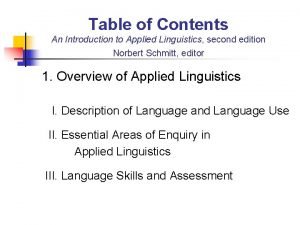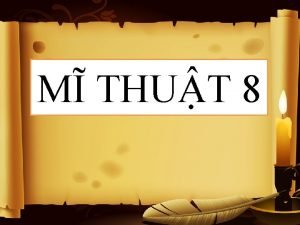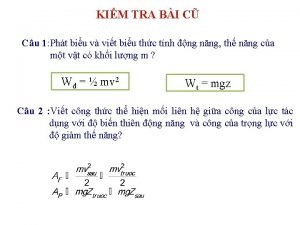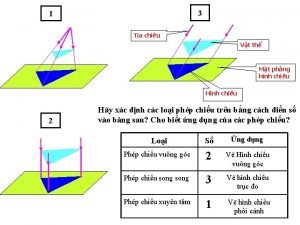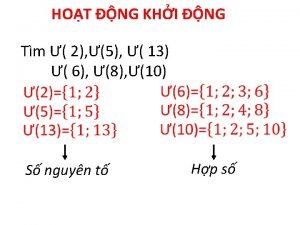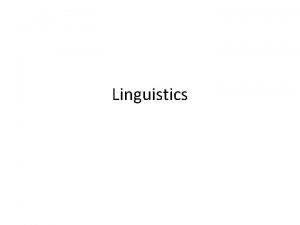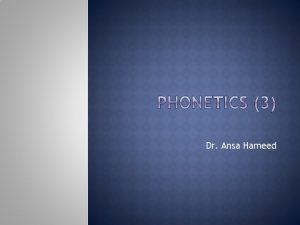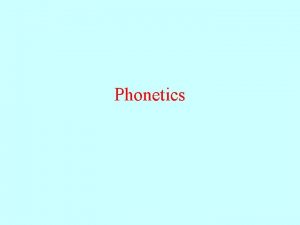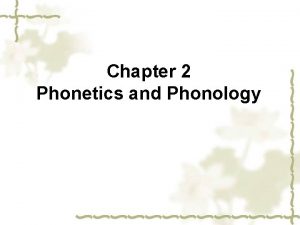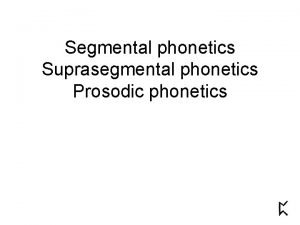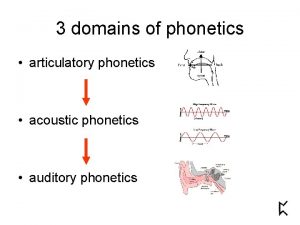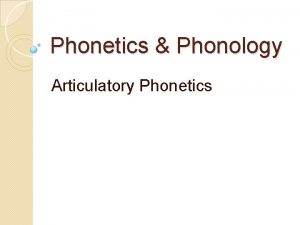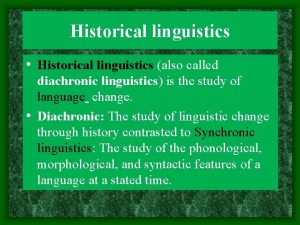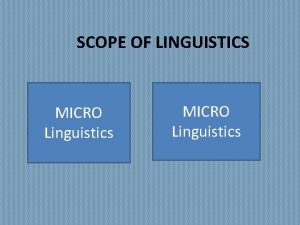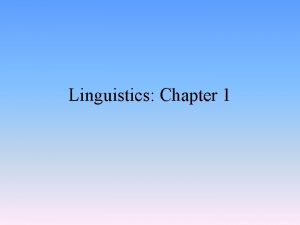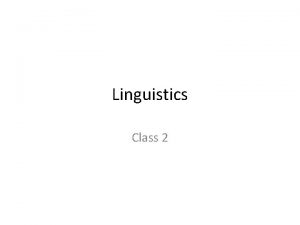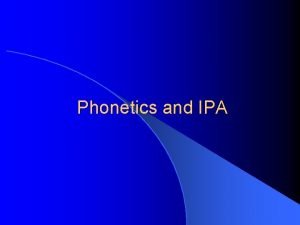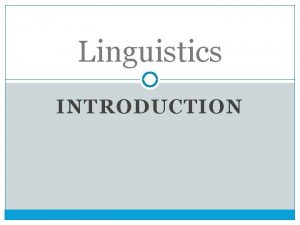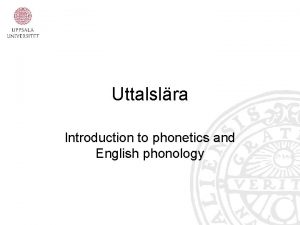PHONETICS An Introduction to Linguistics Phonetics The study









![• labials/bilabials [p], [b], [m] • labials/bilabials [p], [b], [m]](https://slidetodoc.com/presentation_image_h/f0b56fd04f6858a4e6baa1d1b554182d/image-10.jpg)
![• dentals/interdentals [ð] [θ] • dentals/interdentals [ð] [θ]](https://slidetodoc.com/presentation_image_h/f0b56fd04f6858a4e6baa1d1b554182d/image-11.jpg)
![• labiodentals [f], [v] • labiodentals [f], [v]](https://slidetodoc.com/presentation_image_h/f0b56fd04f6858a4e6baa1d1b554182d/image-12.jpg)
![• alveolars [t], [d], [s], [z], [n], [l], • alveolars [t], [d], [s], [z], [n], [l],](https://slidetodoc.com/presentation_image_h/f0b56fd04f6858a4e6baa1d1b554182d/image-13.jpg)


![• glottals [h] • glottals [h]](https://slidetodoc.com/presentation_image_h/f0b56fd04f6858a4e6baa1d1b554182d/image-16.jpg)
![• Summary: place of articulation category places examples bilabials Two lips [b], [p], • Summary: place of articulation category places examples bilabials Two lips [b], [p],](https://slidetodoc.com/presentation_image_h/f0b56fd04f6858a4e6baa1d1b554182d/image-17.jpg)








![• Exercise 1 [p]=voiceless bilabial stop • [v]= • [g]= • [z]= • • Exercise 1 [p]=voiceless bilabial stop • [v]= • [g]= • [z]= •](https://slidetodoc.com/presentation_image_h/f0b56fd04f6858a4e6baa1d1b554182d/image-26.jpg)
![• Exercise 2 • Voiceless interdental fricative= [ ] • Voiced palatal affricate= • Exercise 2 • Voiceless interdental fricative= [ ] • Voiced palatal affricate=](https://slidetodoc.com/presentation_image_h/f0b56fd04f6858a4e6baa1d1b554182d/image-27.jpg)


![• Vowel Chart FRONT BACK ROUND HIGH [i] (T) [I] [u] (T) [U] • Vowel Chart FRONT BACK ROUND HIGH [i] (T) [I] [u] (T) [U]](https://slidetodoc.com/presentation_image_h/f0b56fd04f6858a4e6baa1d1b554182d/image-30.jpg)
![• How to describe a vowel • [vowel]= • Tense/lax + (Rounded) + • How to describe a vowel • [vowel]= • Tense/lax + (Rounded) +](https://slidetodoc.com/presentation_image_h/f0b56fd04f6858a4e6baa1d1b554182d/image-31.jpg)







![• Mandarin Chinese: a tone language segments [ma] Tone pattern High level High • Mandarin Chinese: a tone language segments [ma] Tone pattern High level High](https://slidetodoc.com/presentation_image_h/f0b56fd04f6858a4e6baa1d1b554182d/image-39.jpg)



- Slides: 42

PHONETICS An Introduction to Linguistics

Phonetics The study of speech sounds

• How to ‘write down’ sounds A transcription system should be consistent and unambiguous. One sound One symbol

• Is English a good transcription system? The same sound is spelled differently. • The same letter represents different • sounds A single sound is spelled by more than one letter. Sea, see, receive Sign, pleasure, resign • Shop, chair, special A single letter represents more than • one sound. Exit, use Letters might represents no sound at • all. Doubt, psychology

• What do we use to transcribe the sounds? • IPA • International Phonetic Alphabet

• An anatomy of articulation

• CONSONANTS

• How to describe consonants Voicing Place of articulation Manner of articulation

• PLACE OF ARTICULATION
![labialsbilabials p b m • labials/bilabials [p], [b], [m]](https://slidetodoc.com/presentation_image_h/f0b56fd04f6858a4e6baa1d1b554182d/image-10.jpg)
• labials/bilabials [p], [b], [m]
![dentalsinterdentals ð θ • dentals/interdentals [ð] [θ]](https://slidetodoc.com/presentation_image_h/f0b56fd04f6858a4e6baa1d1b554182d/image-11.jpg)
• dentals/interdentals [ð] [θ]
![labiodentals f v • labiodentals [f], [v]](https://slidetodoc.com/presentation_image_h/f0b56fd04f6858a4e6baa1d1b554182d/image-12.jpg)
• labiodentals [f], [v]
![alveolars t d s z n l • alveolars [t], [d], [s], [z], [n], [l],](https://slidetodoc.com/presentation_image_h/f0b56fd04f6858a4e6baa1d1b554182d/image-13.jpg)
• alveolars [t], [d], [s], [z], [n], [l],


![glottals h • glottals [h]](https://slidetodoc.com/presentation_image_h/f0b56fd04f6858a4e6baa1d1b554182d/image-16.jpg)
• glottals [h]
![Summary place of articulation category places examples bilabials Two lips b p • Summary: place of articulation category places examples bilabials Two lips [b], [p],](https://slidetodoc.com/presentation_image_h/f0b56fd04f6858a4e6baa1d1b554182d/image-17.jpg)
• Summary: place of articulation category places examples bilabials Two lips [b], [p], [m] Labiodentals Lip & teeth [f], [v], Inter-dentals Between teeth [θ], [ð] alveolars Alveolar ridge palatals palate [t], [d], [n], [l] [s], [z] [ž]/[ʒ], [š]/[ʃ], [ʤ], [ʧ]/[č] velars Velum [k]. [g], [ŋ] glottals glottis [h]

• MANNER OF ARTICULATION

• Manner of articulation 1 stops • By forming the complete obstruction of the airstream in the oral cavity • [p, b, t, d, k, g] fricatives • By forming the nearly complete obstruction of the airstream in the vocal tract and therefore producing slight ‘friction’ or ‘turbulence’. • [s, z, ʃ, ʒ] affricates • By shortly obstructing the airstream completely and then releasing it [a stop + a fricative] • [ʤ, ʧ]

• Manner of articulation 2 liquids • The constriction of the airstream is not narrow enough to block the vocal tract or cause turbulence. • [l], [r] glides • By forming a slight closure of the articulators. Little or no obstruction of the airstream with the tongue in gliding fashion • [j], [w] Nasals • By lowering the velum so that the airstream goes through the nasal cavity only. • [m], [n], [ŋ]

• Manner of articulation (1) category distinction example Voiced vs. voiceless Vibration of vocal cord [p] vs. [b] Aspirated vs. unaspirated The ‘timing’ of vocal cord closure Top vs. stop Nasal vs. oral Air thru nose [m], [n], [ŋ]

• Web Resources • Phonetic flash • http: //www. phon. ucl. ac. uk/ho me/johnm/flashin. htm

• VOICING

voicing The vibration of vocal cords voiced voiceless

• How to describe a sound Voicing Place of articulation Manner of articulation Consonant description
![Exercise 1 pvoiceless bilabial stop v g z • Exercise 1 [p]=voiceless bilabial stop • [v]= • [g]= • [z]= •](https://slidetodoc.com/presentation_image_h/f0b56fd04f6858a4e6baa1d1b554182d/image-26.jpg)
• Exercise 1 [p]=voiceless bilabial stop • [v]= • [g]= • [z]= • [ʤ]= • [ŋ]= •
![Exercise 2 Voiceless interdental fricative Voiced palatal affricate • Exercise 2 • Voiceless interdental fricative= [ ] • Voiced palatal affricate=](https://slidetodoc.com/presentation_image_h/f0b56fd04f6858a4e6baa1d1b554182d/image-27.jpg)
• Exercise 2 • Voiceless interdental fricative= [ ] • Voiced palatal affricate= [ ] • Voiceless alveolar stop= [ ] • Voiceless labiodental fricative = [ ] • Bilabial nasal=[ ] • Voiceless palatal fricative= [ ] • Voiced velar stop= [ ]

• VOWELS

• How to describe vowels: criteria • Height • High, mid, low • The • of tongue part of the tongue is involved Front, central, back • Position • of lips Rounded, non-rounded • Tense vs. lax
![Vowel Chart FRONT BACK ROUND HIGH i T I u T U • Vowel Chart FRONT BACK ROUND HIGH [i] (T) [I] [u] (T) [U]](https://slidetodoc.com/presentation_image_h/f0b56fd04f6858a4e6baa1d1b554182d/image-30.jpg)
• Vowel Chart FRONT BACK ROUND HIGH [i] (T) [I] [u] (T) [U] MID [e] (T) [ɛ] [o] (T) [ɔ] LOW [æ] [a]
![How to describe a vowel vowel Tenselax Rounded • How to describe a vowel • [vowel]= • Tense/lax + (Rounded) +](https://slidetodoc.com/presentation_image_h/f0b56fd04f6858a4e6baa1d1b554182d/image-31.jpg)
• How to describe a vowel • [vowel]= • Tense/lax + (Rounded) + High/mid/low + front/back • [æ]= low front vowel • [o]= tense rounded mid back vowel

• SUPRASEGMENTAL FEATURES

suprasegmental Segmental • Individual sounds • length • Intonation • Tone • Stress • Pitch

• Length • The contrast of meaning due to length difference • Inherent differences High vowels are shorter than low vowels • [i] < [æ] • • Influenced • by the sounds around. Bead > beat

• Intonation • The pattern of pitch movements across a stretch of speech • Two intonational patterns Pitch accents • Edge tones •

Pitch accents: The word with particularly higher or lower pitch. JOHN loves Mary. John LOVES Mary. John loves MARY. John loves Mary

Edge tones: Occurs at the end of the phrase John loves Mary! John loves Mary, Alice, and Doris. John loves Mary? . John loves Mary

• Tone • The pitch variation that causes the contrast of meaning. • Level tones • A relatively fixed tone • Contour • tones A single syllable produced with tones that glide from one level to another.
![Mandarin Chinese a tone language segments ma Tone pattern High level High • Mandarin Chinese: a tone language segments [ma] Tone pattern High level High](https://slidetodoc.com/presentation_image_h/f0b56fd04f6858a4e6baa1d1b554182d/image-39.jpg)
• Mandarin Chinese: a tone language segments [ma] Tone pattern High level High rising Low falling rising High falling Tone type Level Contour

• Web Resources • Online Intonation • • http: //www. phon. ucl. ac. uk/ho me/johnm/oi/oiin. htm Pitch • http: //www. phon. ucl. ac. uk/cgi -bin/wtutor? tutorial=pitch

• Summary • Describing consonants Place of articulation • Manner of articulation • Voicing • • Describing • vowels Height, front, roundness • Suprasegmental • features pitch, tone, intonation

Questions?
 Traditional linguistics and modern linguistics
Traditional linguistics and modern linguistics Applied linguistics history
Applied linguistics history Introduction to general phonetics and phonology
Introduction to general phonetics and phonology Linguistics is the scientific study of
Linguistics is the scientific study of The study of linguistics
The study of linguistics The study of language george yule
The study of language george yule Answer key
Answer key An introduction to applied linguistics
An introduction to applied linguistics Lexical category
Lexical category Hình ảnh bộ gõ cơ thể búng tay
Hình ảnh bộ gõ cơ thể búng tay Bổ thể
Bổ thể Tỉ lệ cơ thể trẻ em
Tỉ lệ cơ thể trẻ em Voi kéo gỗ như thế nào
Voi kéo gỗ như thế nào Chụp tư thế worms-breton
Chụp tư thế worms-breton Chúa yêu trần thế
Chúa yêu trần thế Các môn thể thao bắt đầu bằng tiếng đua
Các môn thể thao bắt đầu bằng tiếng đua Thế nào là hệ số cao nhất
Thế nào là hệ số cao nhất Các châu lục và đại dương trên thế giới
Các châu lục và đại dương trên thế giới Cong thức tính động năng
Cong thức tính động năng Trời xanh đây là của chúng ta thể thơ
Trời xanh đây là của chúng ta thể thơ Cách giải mật thư tọa độ
Cách giải mật thư tọa độ 101012 bằng
101012 bằng độ dài liên kết
độ dài liên kết Các châu lục và đại dương trên thế giới
Các châu lục và đại dương trên thế giới Thể thơ truyền thống
Thể thơ truyền thống Quá trình desamine hóa có thể tạo ra
Quá trình desamine hóa có thể tạo ra Một số thể thơ truyền thống
Một số thể thơ truyền thống Bàn tay mà dây bẩn
Bàn tay mà dây bẩn Vẽ hình chiếu vuông góc của vật thể sau
Vẽ hình chiếu vuông góc của vật thể sau Thế nào là sự mỏi cơ
Thế nào là sự mỏi cơ đặc điểm cơ thể của người tối cổ
đặc điểm cơ thể của người tối cổ Giọng cùng tên là
Giọng cùng tên là Vẽ hình chiếu đứng bằng cạnh của vật thể
Vẽ hình chiếu đứng bằng cạnh của vật thể Vẽ hình chiếu vuông góc của vật thể sau
Vẽ hình chiếu vuông góc của vật thể sau Thẻ vin
Thẻ vin đại từ thay thế
đại từ thay thế điện thế nghỉ
điện thế nghỉ Tư thế ngồi viết
Tư thế ngồi viết Diễn thế sinh thái là
Diễn thế sinh thái là Dot
Dot Thế nào là số nguyên tố
Thế nào là số nguyên tố Tư thế ngồi viết
Tư thế ngồi viết







